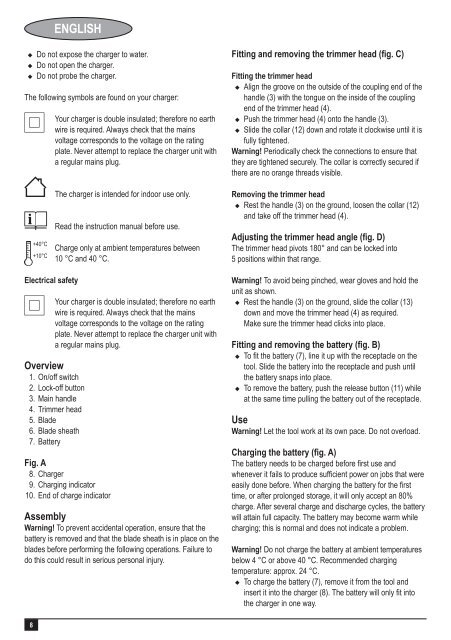BlackandDecker Taille Haies Sans Fil- Gtc800nm - Type H1 - Instruction Manual (Européen)
BlackandDecker Taille Haies Sans Fil- Gtc800nm - Type H1 - Instruction Manual (Européen)
BlackandDecker Taille Haies Sans Fil- Gtc800nm - Type H1 - Instruction Manual (Européen)
You also want an ePaper? Increase the reach of your titles
YUMPU automatically turns print PDFs into web optimized ePapers that Google loves.
ENGLISH<br />
u Do not expose the charger to water.<br />
u Do not op<strong>en</strong> the charger.<br />
u Do not probe the charger.<br />
The following symbols are found on your charger:<br />
#<br />
Your charger is double insulated; therefore no earth<br />
wire is required. Always check that the mains<br />
voltage corresponds to the voltage on the rating<br />
plate. Never attempt to replace the charger unit with<br />
a regular mains plug.<br />
$ The charger is int<strong>en</strong>ded for indoor use only.<br />
+ Read the instruction manual before use.<br />
Electrical safety<br />
#<br />
Charge only at ambi<strong>en</strong>t temperatures betwe<strong>en</strong><br />
10 °C and 40 °C.<br />
Your charger is double insulated; therefore no earth<br />
wire is required. Always check that the mains<br />
voltage corresponds to the voltage on the rating<br />
plate. Never attempt to replace the charger unit with<br />
a regular mains plug.<br />
Overview<br />
1. On/off switch<br />
2. Lock-off button<br />
3. Main handle<br />
4. Trimmer head<br />
5. Blade<br />
6. Blade sheath<br />
7. Battery<br />
Fig. A<br />
8. Charger<br />
9. Charging indicator<br />
10. End of charge indicator<br />
Assembly<br />
Warning! To prev<strong>en</strong>t accid<strong>en</strong>tal operation, <strong>en</strong>sure that the<br />
battery is removed and that the blade sheath is in place on the<br />
blades before performing the following operations. Failure to<br />
do this could result in serious personal injury.<br />
Fitting and removing the trimmer head (fig. C)<br />
Fitting the trimmer head<br />
u Align the groove on the outside of the coupling <strong>en</strong>d of the<br />
handle (3) with the tongue on the inside of the coupling<br />
<strong>en</strong>d of the trimmer head (4).<br />
u Push the trimmer head (4) onto the handle (3).<br />
u Slide the collar (12) down and rotate it clockwise until it is<br />
fully tight<strong>en</strong>ed.<br />
Warning! Periodically check the connections to <strong>en</strong>sure that<br />
they are tight<strong>en</strong>ed securely. The collar is correctly secured if<br />
there are no orange threads visible.<br />
Removing the trimmer head<br />
u Rest the handle (3) on the ground, loos<strong>en</strong> the collar (12)<br />
and take off the trimmer head (4).<br />
Adjusting the trimmer head angle (fig. D)<br />
The trimmer head pivots 180° and can be locked into<br />
5 positions within that range.<br />
Warning! To avoid being pinched, wear gloves and hold the<br />
unit as shown.<br />
u Rest the handle (3) on the ground, slide the collar (13)<br />
down and move the trimmer head (4) as required.<br />
Make sure the trimmer head clicks into place.<br />
Fitting and removing the battery (fig. B)<br />
u To fit the battery (7), line it up with the receptacle on the<br />
tool. Slide the battery into the receptacle and push until<br />
the battery snaps into place.<br />
u To remove the battery, push the release button (11) while<br />
at the same time pulling the battery out of the receptacle.<br />
Use<br />
Warning! Let the tool work at its own pace. Do not overload.<br />
Charging the battery (fig. A)<br />
The battery needs to be charged before first use and<br />
wh<strong>en</strong>ever it fails to produce suffici<strong>en</strong>t power on jobs that were<br />
easily done before. Wh<strong>en</strong> charging the battery for the first<br />
time, or after prolonged storage, it will only accept an 80%<br />
charge. After several charge and discharge cycles, the battery<br />
will attain full capacity. The battery may become warm while<br />
charging; this is normal and does not indicate a problem.<br />
Warning! Do not charge the battery at ambi<strong>en</strong>t temperatures<br />
below 4 °C or above 40 °C. Recomm<strong>en</strong>ded charging<br />
temperature: approx. 24 °C.<br />
u To charge the battery (7), remove it from the tool and<br />
insert it into the charger (8). The battery will only fit into<br />
the charger in one way.<br />
8
















